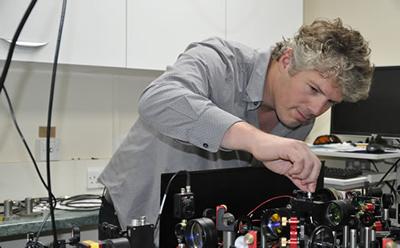Nanoantenna lightning-rod effect produces fast optical switches

A team of scientists, led by the University of Southampton, have produced a fast nanoscale optical transistor using gold nanoantenna assisted phase transition.
The work, published in the journal Light, Science and Applications, opens up new directions in antenna-assisted switches and optical memory.
Small nanostructures that can interact strongly with light are of interest for a range of emerging new applications including small optical circuits and metasurface flat optics. Nanoantennas are designed to have strong optical resonances where energy is concentrated far below the diffraction limit, the smallest scale possible using conventional optics. Such extreme concentration of light can be used to enhance all kinds of effects related to localised energy conversion and harvesting, coupling of light to small molecules and quantum dots, and generating new frequencies of light through nonlinear optics.
Next to precise tuning of these antennas by design, an ability to actively tune their properties is of great interest.
Lead author Professor Otto Muskens, from the University of Southampton, said: “If we are able to actively tune a nanoantenna using an electrical or optical signal, we could achieve transistor-type switches for light with nanometer-scale footprint for datacommunication. Such active devices could also be used to tune the antenna’s light-concentration effects leading to new applications in switchable and tuneable antenna-assisted processes.”

The Southampton team used the properties of the antenna itself to achieve low energy optical switching of a phase-change material. The material used to achieve this effect was vanadium dioxide. Vanadium dioxide is a special material with properties that can be switched from an insulator to a metal by increasing the temperature above the phase transition point (68 °C). Fabrication of this material is challenging and was produced by a team at the University of Salford, who specialise in thin-film deposition and who were able to grow very high quality films of this material.
Gold nanoantennas were fabricated on top of this thin film and were used to locally drive the phase transition of the vanadium dioxide.
Professor Muskens explained: “The nanoantenna assists the phase transition of the vanadium dioxide by locally concentrating energy near the tips of the antenna. It is like a lightning-rod effect. These positions are also where the antenna resonances are the most sensitive to local perturbations. Antenna-assisted switching thus results a large effect while requiring only a small amount of energy.”
The theoretical modelling was done by a team from the University of the Basque Country in San Sebastian, Spain. Their detailed calculations revealed that the nanoantennas provided a new pathway by local absorption around the antenna. The antenna-assisted mechanism resulted in a much lower switching energy compared to just the VO2 film, corresponding to picojoule energies and a calculated efficiency of over 40 per cent.
Links to external websites
The University cannot accept responsibility for external websites.